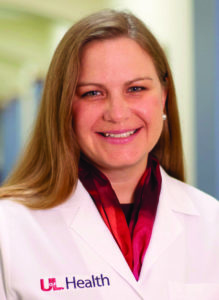
LOUISVILLE The treatment of head and neck cancers has long had the potential to damage sensitive, quality of life-giving tissues. Rebecca Redman, MD, at UofL Health — Brown Cancer Center is working on multiple fronts to eliminate these side effects for Kentuckians. Redman’s research and practice are centered on two things: the reality that head and neck cancer patients are living beyond their treatments at a high rate; and her belief that they deserve a future with full functionality. She is devoted to making it possible for these patients to breathe, smell, taste, chew, hear, and talk like they did before their diagnosis, and she sees a successful future powered by a variety of tools. “With smarter treatments, we are on trajectory to increase survival and minimize side effects,” she says.
Redman initially sought a bachelor’s degree in medical genetics with plans to be a genetic counselor, but the science of genetics in her undergraduate studies got her thinking about medicine. Then, a fortuitous work study placement exposed her to a philosophy which she holds to this day. Working in a pediatric oncologist’s lab, she envied his mix of lab work and seeing patients. She observed how his experience with patients enlightened his research and lab practices. “It brought together those two worlds, my interest in science and my interest in medicine,” she reflects. This informed bench to bedside approach in the form of collaboration with basic science colleagues would be one she continued in her professional life.
The Road to UofL Health
After medical school at University of Wisconsin, Redman went to UNC Hospitals, Chapel Hill for her internal medicine residency and Duke University Medical Center for a medical oncology fellowship. Her marriage to a Kentuckian got her looking at UofL Health, and she was taken by the good fit she perceived upon interviewing. The people at Brown were the key, “I felt like it was a place where I would be supported and able to treat patients in a collaborative, thoughtful way,” she says.
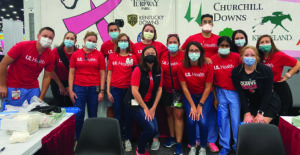
Head and neck cancer treatment at Brown Cancer Center is truly interdisciplinary. A patient is usually referred to Brown from their ENT physician, or possibly a gastroenterologist. The patient then gets a devoted team that includes a surgeon, medical oncologist, radiation oncologist, dietician, and speech therapist, among others. Together, they review the case and see the patient in clinic. This way the patient does not have to go to three different appointments. Most of the Brown head and neck patients have oral cavity or throat cancer issues, with some sinus and salivary glands cancers. With 60–70,000 diagnoses in the US per year, these constitute only 4% of all cancer diagnoses, but there is a high incidence in the Ohio Valley, where tobacco use and HPV cases are common. While relatively rare, head and neck cancers have a disproportionate impact, because of the basic daily functions treatment of these cancers can affect.
From Bench to Bedside and Back to Bench
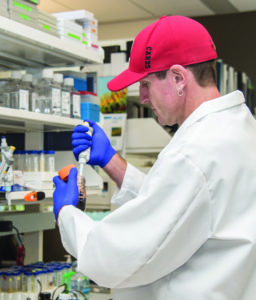
Today Redman sees patients three day per week, is an associate professor at the UofL School of Medicine, the director of medical oncology service for the Head and Neck Cancer Multidisciplinary Clinic, and the deputy director of clinical research for the UofL Health — Brown Cancer Center Clinical Trials Office. She infuses each role with her concern for a patient’s life after cancer treatment, but it is in the latter where she may be having her greatest impact. She oversees all the phase 1, 2, and 3 trials at Brown, conducted by an entire team of dedicated research coordinators, nurses, and specialists, who are as fiercely devoted to improving the care of cancer patients as she is.
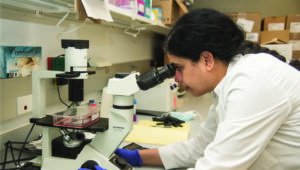
Clinical phase 1 trials offer two levels of hope. These trials may involve a first-time study of the agent in humans or brand-new drugs and combinations of existing drugs. For people with advanced cancer for whom standard treatments are not enough, participation in trials presents the possibility of a home run, a miracle drug breakthrough that gives them another chance. More often, however, it allows her patients a role in moving the field forward and the knowledge that they are helping tomorrow’s cancer sufferers. She says “Many of my patients find participating in phase 1 trials really rewarding.” Redman’s relationship with her patients is powerfully informed by both what she learns from collaboration with basic scientists and the meaning and hope clinical trials can bring them.
Treating with an Eye for Life after Cancer
More and more cancer patients are outliving their disease, so with an increasing emphasis on survivorship, research is focused on finding treatments that are more effective and less toxic. This is because the head and neck are very sensitive areas. Preserving the function of those organs and tissues is a major preoccupation, so Redman and her colleagues are always looking at the impact on function when considering treatment.
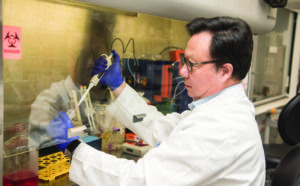
Traditional cancer treatments – radiation, chemotherapy, surgery – can cause complications or long-term health problems, affecting how a patient might eat, talk, hear, and breathe, not to mention how they look. Nerve damage, due to tumor removal, radiation, or some chemo drugs, can result in numbness in the jaw, throat, or neck, and scar tissue can be problematic over time. A change in how food smells and tastes, dry mouth, and dental problems can all make it hard to eat and drink enough to get the nutrients and fluids a patient needs to live a vigorous life.
For Redman, these treatments will always have a place, but figuring out how to use them with less impact and, more importantly, finding non-invasive alternatives is a goal. “For patients to survive with as much quality of life as possible, has to be our focus,” she says. Many of her research projects have involved advancing such treatments. According to the UofL Health website, some of Redman’s projects have included novel approaches to mitigate toxicities of chemotherapy and radiation, trials of small molecules that target the metabolism of cancer cells, and harnessing the immune system to control cancer. Personalized medicine, however, is key in this, with immunotherapy among the main routes to preparing patients for a side-effect free life after cancer.
Unmasking Tumors and Making Smart Blood Cells: A Bright Future
Redman is most excited about immunotherapy, which she summarizes simply: “The drug itself is not killing the cancer but trying to get the immune system to do so.” Making the immune system smarter is the next wave in cancer treatment and one Redman fully expects to ride for some time. Foremost among these are checkpoint inhibitors and tumor infiltrating lymphocytes.
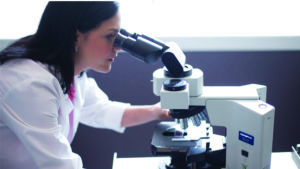
Checkpoint inhibitors essentially unmask a tumor, which allows the immune system to recognize the cancer as something that should not be there and destroy it. The treatment drug does not interact directly with the cancer, but rather inhibits certain proteins from binding on the tumors and concealing them from the immune system. Tumor infiltrating lymphocytes are a novel personalized medical treatment. White blood cells are extracted from a patient’s tumor, cultivated into large populations in the lab, and then this army of cancer-fighting lymphocytes is reinfused into the patient. By focusing on those lymphocytes that are already programmed to fight that cancer, it allows for a more targeted attack on the cancer cells and is being studied in conjunction with checkpoint inhibitors for increased effectiveness.
Redman summarizes that the goal of immunotherapy is “manipulating the patient’s immune system to try to make it more effective at fighting that individual’s cancer.” She feels that five years from now, cancer treatment will be all about immunotherapy. “It is here to stay, and it is a game changer when it comes to cancer treatment,” she states.
While currently immunotherapy only benefits a minority of patients, she thinks that will change, and that designing smarter drugs will make that possible. Many of her phase 1 trials are at the leading edge of this, and everyone at Brown Cancer Center is very focused on its potential. “This is incredibly important to all of us, from our trial clinicians up to our director, Dr. Jason Chesney. Kentuckians should be able to get these treatments here and not have to travel to Houston or Cleveland for them,” she concludes.
Leading Research, Empowering Patients
Back at the bedside, Redman is an advocate for patient involvement and empowerment. She supports her patients inquiring about non-traditional and alternative medicines. She says, “We don’t have all the answers. There may be things out there that can help. We have not beaten cancer yet.” She encourages patients to come with questions and ideas. “I tell them there are certainly things out there that may benefit them, but they should bring them to me so I can help them make sense of them.” She also encourages her patients to be part of clinical trials when appropriate. “My patients who have done so tell me it has been rewarding. They feel that they are part of moving cancer care forward,” she recalls.
Redman empowers and supports her patients, and she says, “I treat them as I would expect a family member to be treated; cancer treatment is a shared decision between us to decide what path to go down.” She knows that path is only getting wider and smoother, in part because of her work. “My goal is to help patients live as great a life as they can for as long as they can,” she concludes. With Redman’s research, her directorship at Brown, and her philosophy of patient care, Brown Cancer Center patients can rest assured that such an outcome is possible for them.



